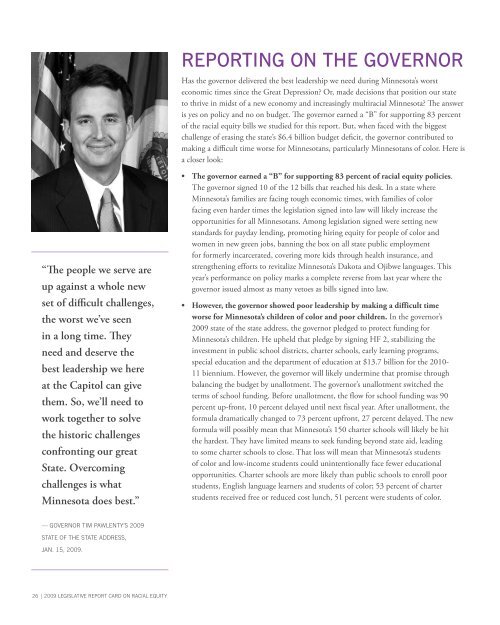minnesota legislative report card on racial equity - Organizing ...
minnesota legislative report card on racial equity - Organizing ...
minnesota legislative report card on racial equity - Organizing ...
- No tags were found...
You also want an ePaper? Increase the reach of your titles
YUMPU automatically turns print PDFs into web optimized ePapers that Google loves.
Reporting <strong>on</strong> the governorHas the governor delivered the best leadership we need during Minnesota’s worstec<strong>on</strong>omic times since the Great Depressi<strong>on</strong>? Or, made decisi<strong>on</strong>s that positi<strong>on</strong> our stateto thrive in midst of a new ec<strong>on</strong>omy and increasingly multi<strong>racial</strong> Minnesota? The answeris yes <strong>on</strong> policy and no <strong>on</strong> budget. The governor earned a “B” for supporting 83 percentof the <strong>racial</strong> <strong>equity</strong> bills we studied for this <str<strong>on</strong>g>report</str<strong>on</strong>g>. But, when faced with the biggestchallenge of erasing the state’s $6.4 billi<strong>on</strong> budget deficit, the governor c<strong>on</strong>tributed tomaking a difficult time worse for Minnesotans, particularly Minnesotans of color. Here isa closer look:“The people we serve areup against a whole newset of difficult challenges,the worst we’ve seenin a l<strong>on</strong>g time. Theyneed and deserve thebest leadership we hereat the Capitol can givethem. So, we’ll need towork together to solvethe historic challengesc<strong>on</strong>fr<strong>on</strong>ting our greatState. Overcomingchallenges is whatMinnesota does best.”• The governor earned a “B” for supporting 83 percent of <strong>racial</strong> <strong>equity</strong> policies.The governor signed 10 of the 12 bills that reached his desk. In a state whereMinnesota’s families are facing tough ec<strong>on</strong>omic times, with families of colorfacing even harder times the legislati<strong>on</strong> signed into law will likely increase theopportunities for all Minnesotans. Am<strong>on</strong>g legislati<strong>on</strong> signed were setting newstandards for payday lending, promoting hiring <strong>equity</strong> for people of color andwomen in new green jobs, banning the box <strong>on</strong> all state public employmentfor formerly incarcerated, covering more kids through health insurance, andstrengthening efforts to revitalize Minnesota’s Dakota and Ojibwe languages. Thisyear’s performance <strong>on</strong> policy marks a complete reverse from last year where thegovernor issued almost as many vetoes as bills signed into law.• However, the governor showed poor leadership by making a difficult timeworse for Minnesota’s children of color and poor children. In the governor’s2009 state of the state address, the governor pledged to protect funding forMinnesota’s children. He upheld that pledge by signing HF 2, stabilizing theinvestment in public school districts, charter schools, early learning programs,special educati<strong>on</strong> and the department of educati<strong>on</strong> at $13.7 billi<strong>on</strong> for the 2010-11 biennium. However, the governor will likely undermine that promise throughbalancing the budget by unallotment. The governor’s unallotment switched theterms of school funding. Before unallotment, the flow for school funding was 90percent up-fr<strong>on</strong>t, 10 percent delayed until next fiscal year. After unallotment, theformula dramatically changed to 73 percent upfr<strong>on</strong>t, 27 percent delayed. The newformula will possibly mean that Minnesota’s 150 charter schools will likely be hitthe hardest. They have limited means to seek funding bey<strong>on</strong>d state aid, leadingto some charter schools to close. That loss will mean that Minnesota’s studentsof color and low-income students could unintenti<strong>on</strong>ally face fewer educati<strong>on</strong>alopportunities. Charter schools are more likely than public schools to enroll poorstudents, English language learners and students of color; 53 percent of charterstudents received free or reduced cost lunch, 51 percent were students of color.— Governor Tim Pawlenty’s 2009State of the State Address,Jan. 15, 2009.26 | 2009 <str<strong>on</strong>g>legislative</str<strong>on</strong>g> Report Card <strong>on</strong> Racial Equity



